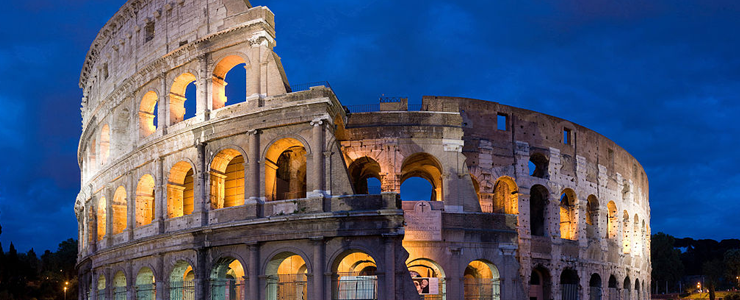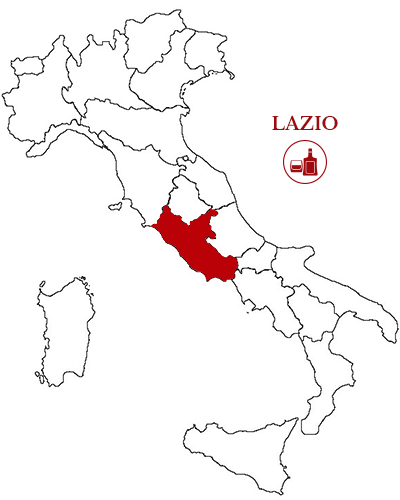LAZIO Region


The region
Lazio, a region in the centre of Italy, occupies 17.207 kilometres of the Italian territory, it extends from the Apennines to the Tyrrhenian sea. Its territory is heterogeneous, mainly made of hills – for about the 55%- the 25% is covered with mountains and the remaining part is flat country along the sea. The mountain area is located in the hinterland along the Apennines ridge, the remaining area is formed of mild hills ending with flatlands towards the sea. The hilly land is mainly of volcanic origin and it is characterized by the presence of many lakes, volcanic originated indeed, which create several microclimates that make rich the surrounding agriculture. This is why the climate reveals a remarkable variability from one place to another creating very rich agricultural areas such as the hilly area of the Castelli Romani, including the most relevant vineyard settlement of the region which is extended all the way to the sea and is right behind the door of Rome that is the county seat and the place with the most numerous hours of sunlight and sunny days of the year. Lazio, just like the rest of the Italian territory, is very rich of history, especially the one regarding the Roman Empire and its historical evidences in Italy and Europe, in addition to the evidences left here by the Etruscan civilization.
AGRICULTURAL ACTIVITY
Apart from Rome, which is essential for the economy of Lazio, the main strengths of the region are agriculture and pastoralism. New cultivations have been introduced in the Lazio region by the measures taken to reclaim the swamplands. The agricultural activities, are practised differently from place to place, but in almost the entire region – mostly in the hilly areas - the agriculture is directly managed by farmers with a farm density superior of even 50 hectares of field range. Also the distribution of plantations is different from place to place, according to the exposition of the lands, the variety of the soil, the rainfall distribution, the possibility of irrigation, the use of agricultural machineries. Because of the historical and cultural background and the agricultural and gastronomic traditions, it can be told that the territory of Lazio distinguishes itself for simple and natural ingredients, strongly characterized by an authentic mark which is essentially based on three products: wine, oil and cheese. The olive tree plantations, which are very ancient, come from the DOP Canino and Sabina, the famous oils of Priverno, Farnese and Sonnino and many important oils called “the oils of Lazio – masterpiece of Taste”. In the areas of Ciociaria, Frusinate, Viterbese and mostly on the hills of the castelli romani, stands on the cultivation of the grapevine, which is focused especially just before Rome and to follow the province of Latina and Frosinone with excellent results of DOC and DOCG quality products. Another top product of local wine and food production is cheese: hard cheese – like the well-known percorino romano DOP; semi-hard cheese – like provolone and caciocavallo and soft cheese, like the buffalo mozzarella, scamorza and the ricotta romana DOP. In the province of Rieti we may find truffle enriched dishes, truffle of Cicolano and Scorzone truffle. The province of Frosinone offers the delicious sausages of Filettino and the puntarelle, tasty vegetables that can be eaten in many different ways. And lastly, from Latina we have the well-know olives of Gaeta, the buffalo mozzarella and the air-cured beef, savory ricotta from the agro pontino and the unique prosciutto of Bassiano and the unforgettable Tiella of Gaeta. On the list of these delicacies it can’t be skipped the famous artichokes of Sezze in the province of Latina and the ones from Cerveteri in the province of Rome. This rich reality in Lazio, inspired regional organizers and private associations to define some eno-gastronomic itineraries for amateurs in order to better appreciate the treasures of the typical areas of Lazio, giving birth to the wine , oil and cheese tours.
GASTRONOMY
Cookery of Lazio offers a remarkable variety of dishes and typical products, about 90% wholly originated from there, with slight variations influenced by the surrounding regions. Many roman recipes use vegetables grown in the roman countryside such as the famous roman artichokes and the zucchini omelette cooked with extra-virgin olive oil DOC and the entrails, carefully selected by roman butchers. Among the most famous pasta dishes we have the Bucatini all’amatriciana, rigatoni cheese and pepper, rigatoni carbonara, penne all’arrabbiata, rigatoni with pajata. The province of Rome offers the handmade bread of Genzano, the typical porchetta of Ariccia and the coppiette of horse meat and pork meat, that can be eaten in the famous fraschette, peculiar little restaurants where you can taste the most traditional flavours of Lazio. The legumes soups are prerogatives of the province of Viterbo (lentils of Onano) and the acquacotta. Among the desserts, the maritozzi, soft éclairs filled with cream, probably a recipe well-known by the romans themselves.
WINES AND WINE TRAILS
The itineraries are very exciting, you can travel from the “Wine tour of the Castelli Romani” to the “Oil, wine and typical products tours of the Tuscia”, from the “wine tour of the Alta Tuscia” to the “wine Cesanese tour”, from the “wine of the Teverina tour” to the “wine tour of the province of Latina”. The hilly areas in Lazio give birth to important wines such as the Cesanese del Piglio DOCG, the Cannellino of Frascati DOCG and the Frascati Superiore DOCG. White wines are mainly obtained by Malvasie and Trebbiani, among them we can mention: Malvasia Bianca Lunga, Malvasia di Candia and Malvasia puntinata or of the Lazio (with the clones Bellone, Cacchione and white Bonbino); Trebbiano Giallo and Trebbiano of Tuscany or of Lazio. Trebbiani and Malvasie are also the basis for the DOC Est! Est! Est! Wine of Montefiascone. Not to mention, among the white wines the Grechetto, vine variety cultivated especially in the area of Viterbo, neat the Umbria borders. Among the red grapes, beyond the Montepulciano, Merlot, Ciliegiolo and Cabernet Sauvignon, in some cases we have the Barbera too. But, the most important local red vine variety is for sure the CESANESE that is, just like we said, the basis of absolutely excellent wines and it is mostly cultivated around the province of Frosinone, in the area of Affile and Olevano Romano with the creation of good DOC products along with the above mentioned DOCG. But the remarkable wine area is the one on the CASTELLI ROMANI, located to the south of Rome where you can count the already mentioned DOCG of Frascati, the DOC of Colli Albani, Marino, Velletri, Colli Lanuvini, Merlot of Aprilia and Castelli Romani with the late addition of the DOC ROMA.
